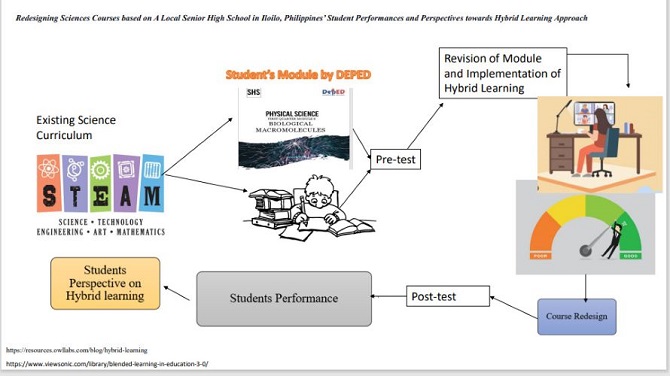
Redesigning Sciences Courses based on A Local Senior High School in Iloilo, Philippines’ Student Performances and Perspectives towards Hybrid Learning Approach
Abstract
This study aimed to examine learners' perspectives on the hybrid learning approach, using printed modules and social media as learning materials to redesign science courses and improve their performances. This study involved 37 students from Tacuyong Sur National High School, 20 from the Grade 9 class and 17 from the Grade 12 Technical Vocational Livelihood (TVL) class in the fourth quarter of the school year 2021-2022. The 5-items multiple-choice test assesses student performance. A survey question determined learners' perspectives on hybrid learning after revising the delivery mode for science courses. Student performances based on their pre-test/post-test revealed the benefits and problems connected with the hybrid learning approach. Program for statistical analysis of sampled data (PSPP) interpreted the survey and student performance. Hybrid learning survey results revealed a practical approach to improve science learners' performances during the COVID-19 pandemic. Data results through teacher-technology innovation demonstrated the effectiveness of hybrid learning techniques to help teachers and curriculum planners redesign course subjects that improve science student performances.
Full Text:
Download PDFReferences
Abu Alhaija, E., Ali, K., Al-Fodeh, R., Alwahadni, A., Bani-Hani, T., Daher, D., & Daher, S. (2021). Quality, effectiveness, and outcome of blended learning in dental education during the COVID pandemic: Prospects of a post-pandemic implementation. Education Sciences, 1(12), 810. https://doi.org/10.3390/educsci11120810.q
Alfiras, M., Bojiah, J., Nagi, M., & Sherwani, M. (2021). Students’ perceptions of hybrid classes in the context of Gulf University: An analytical study. Journal of Hunan University Natural Sciences, 48(5), 181–188.
Afzal, M., Gulmira, T., Gulnara N., Helmer, J., Jonbekova, D., & Malone K. (2019). Challenges and benefits of blended learning in higher education. International Journal of Technology in Education, 2(1), ISSN: 2689-2758.
Akib, E., Baso, F. A., & Talis, S. S. N. (2018). The students’ perception toward implementing blended learning method in English Language Teaching (ELT) at the 5th semester students of English Education Department (A descriptive qualitative research). Jurnal Keguruan Dan Ilmu Pendidikan (JKIP), 5(1), 37–51. https://www.researchgate.net/publication/326732132.
Aycock, A., Barkley, E., Behnke, C., Gau, T., Glazer, F., & Hartwell, R. (2012). Blended learning: Across the disciplines, across the academy. Journal of Teaching and Learning with Technology, 1(2), 59 – 61.
Boyarsky, K. (2021). What is hybrid learning? Here’s everything you need to know. Retrieved from https://resources.owllabs.com/blog/hybrid-learning.
Dziuban, C., Graham, C., Moskal, P., Norberg, A., & Sicilia, N. (2018). Blended learning: the new normal and emerging technologies. International Journal of Educational Technology in Higher Education, 15(3), 1-16. DOI 10.1186/s41239-017-0087-5.
Erliza, S. & Septianingsih, P. (2022). Undergraduate students' perception of hybrid learning: Voices from English language education students in pandemic era. Journal of English Language Teaching and Linguistics, 7(1), 231-243. DOI:10.21462/jeltl.v7i1.782.
Garrison, D., & Vaughan, N. (2008). Blended learning in higher education: Framework, principles, and guidelines. 10.1002/9781118269558.
Hill, J., & Smith, K. (2018). Defining the nature of blended learning through its depiction in current research. Higher Education Research & Development, 38, 1-15. 10.1080/07294360.2018.1517732.
Laili, R., & Nashir, M. (2021). Hybrid learning as an effective learning solution on intensive English program in the new normal era. Journal of Language Teaching and Learning, Linguistics and Literature, 9(2), 220– 232. DOI: 10.24256/ideas. v912.2253.
Lim, H., & Mali, D. (2021). How do students perceive face-to-face/ blended learning as a result of the Covid-19 pandemic?. The International Journal of Management Education, 9(3). https://doi.org/10.1016/j.ijme.2021.100552.
Midun, H., & Rorimpandey, W. (2021). Effect of hybrid learning strategy and self-efficacy on learning outcomes. Journal of Hunan University Natural Sciences, 48(8). ISSN 1674-2974.
Rabail A., & Tayyaba, G. M. (2019). Comparative analysis between pre-test/post-test model and post-test-only model in achieving the learning outcomes. Pakistan Journal of Ophthalmology, 35(1).
Rerung, M. K. T. (2018). Students’ perception on blended learning in English listening and speaking class. Journal of English Language and Culture, 9(1), 17–28.
Rita, Y., & Safitri, N. (2020). Blended Learning in Package C Equality Programs in Facing New Normal Education. KOLOKIUM Jurnal Pendidikan Luar Sekolah, 8(2), 165-170.
Simbolon, N. E. (2021). EFL students’ perceptions of blended learning in English language course: Learning experience and engagement. Journal on English as a Foreign Language, 11(1), 152–174. https://doi.org/10.23971/jefl.v11i1.2518.
Singh, J., Singh, L., & Steele, K. (2021). Combining the best of online and face-to-face learning: Hybrid and blended learning approach for COVID-19, post vaccine, & post pandemic world. Journal of Educational Technology Systems 2021, 50(2), 140–171. DOI: 10.1177/00472395211047865.
DOI: https://doi.org/10.17509/jsl.v6i2.51743
Refbacks
- There are currently no refbacks.
Copyright (c) 2023 Donna Hembra Gabor, Leona Marie Canaway Camano

This work is licensed under a Creative Commons Attribution-ShareAlike 4.0 International License.


Jl. Dr. Setiabudhi 229 Bandung 40154, West Java, Indonesia











